wideband experience
#2
I have the NGK Powerdex AFX and I like it so far.
Pretty reasonable price also.
Only "downside" is the display. It's kinda big and there is no real good spot for mounting it.
I currently have it in my glovebox. Works good. Made a bracket to where it's positioned towards the driver. When I want to watch it, I open the glovebox and there it is.
It would be cool to have more of a guage mount for the wideband display.
Cleaner looking and I could mount it in my A-pillar.
There are a couple good posts on different Widebands.
Run a quick search and you should find some.
Pretty reasonable price also.
Only "downside" is the display. It's kinda big and there is no real good spot for mounting it.
I currently have it in my glovebox. Works good. Made a bracket to where it's positioned towards the driver. When I want to watch it, I open the glovebox and there it is.
It would be cool to have more of a guage mount for the wideband display.
Cleaner looking and I could mount it in my A-pillar.
There are a couple good posts on different Widebands.
Run a quick search and you should find some.
#3
I have the NGK Powerdex AFX and I like it so far.
Pretty reasonable price also.
Only "downside" is the display. It's kinda big and there is no real good spot for mounting it.
I currently have it in my glovebox. Works good. Made a bracket to where it's positioned towards the driver. When I want to watch it, I open the glovebox and there it is.
It would be cool to have more of a guage mount for the wideband display.
Cleaner looking and I could mount it in my A-pillar.
There are a couple good posts on different Widebands.
Run a quick search and you should find some.
Pretty reasonable price also.
Only "downside" is the display. It's kinda big and there is no real good spot for mounting it.
I currently have it in my glovebox. Works good. Made a bracket to where it's positioned towards the driver. When I want to watch it, I open the glovebox and there it is.
It would be cool to have more of a guage mount for the wideband display.
Cleaner looking and I could mount it in my A-pillar.
There are a couple good posts on different Widebands.
Run a quick search and you should find some.

#5
I feel that it's a fair price for a high quality unit and sensor.
Also uses the NTK sensor instead of the Bosch.
Seems like quite a few guys like the NTK sensor. Seems as if it's more durable.
Do some searching about WB units and read other peoples experiences.
Not saying NGK is the best. Just stating my experience so far.
This is the only WB I have owned so this is just my opinion.
What WB are you running? Likes/dislikes?
#6
Racing Rotary Since 1983
iTrader: (6)
Joined: Oct 2001
Posts: 6,135
Likes: 563
From: Florence, Alabama
you asked specifically about sensors... here's an interesting comparison re the newer Bosch item which i will be running in my new setup...
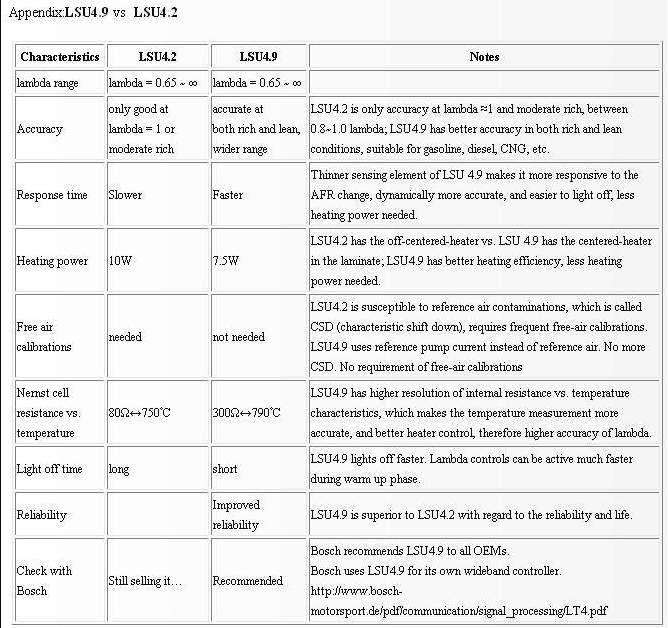
i am not knocking NTK, just drawing a distinction between the sensor that is in most aftermarket kits and the sensor that Bosch is putting in every new OE app.
howard

i am not knocking NTK, just drawing a distinction between the sensor that is in most aftermarket kits and the sensor that Bosch is putting in every new OE app.
howard
Trending Topics
#8
my problem is that when i'm on the dyno, my aem wideband and techedge wideband both read differently than the wide band on the dyno. all sensors are located at the same location at the tail pipe. so my thing is which one do i follow? leaner or richer one? $300 is not a bad price, i paid about $500 for my techedge.
$300 is not a bad price, i paid about $500 for my techedge.
 $300 is not a bad price, i paid about $500 for my techedge.
$300 is not a bad price, i paid about $500 for my techedge.
#9
my problem is that when i'm on the dyno, my aem wideband and techedge wideband both read differently than the wide band on the dyno. all sensors are located at the same location at the tail pipe. so my thing is which one do i follow? leaner or richer one? $300 is not a bad price, i paid about $500 for my techedge.
$300 is not a bad price, i paid about $500 for my techedge.
 $300 is not a bad price, i paid about $500 for my techedge.
$300 is not a bad price, i paid about $500 for my techedge.Heat and pressure, among other things, effect the reading you get from the sensor. The controller needs to be able to accommodate for this. This is what separates lab grade and hobbyist level electronics. A lot of dyno setups don't even have high quality meters. Once you put the sensors in a real working environment, it's not surprising you get skewed readings.
FWIW, the NGK AFX is what I always recommend as a budget solution. The unit is made by ECM, which is known for their lab grade meters used by many OEMs and also used as the control meter is some of the wideband tests the magazines have done over the years. We've tested the NGK AFX side-by-side with an ECM AFM1000 and the readings were essentially identical.
The Bosch 4.9 may be a good sensor on paper, but all of the Bosch sensors are less tolerant of leaded fuels and more likely to have their output skewed by heat and pressure. The NTK sensors are still the used for lab grade analysis by companies like Horiba and ECM.
#11
I run the fjo with the ntk sensor. I have had a few others but this has been my favorite.
And I agree with Ludwig, I would get a few dyno pulls made and the Bosch units would crap out. My ntk has been in for a few years now and still reads the same!
Don't remember what I paid for it though...
Btw... What's my boy Dorian been up to? I still want that damn rx3 of his!
And I agree with Ludwig, I would get a few dyno pulls made and the Bosch units would crap out. My ntk has been in for a few years now and still reads the same!
Don't remember what I paid for it though...
Btw... What's my boy Dorian been up to? I still want that damn rx3 of his!
#12
my problem is that when i'm on the dyno, my aem wideband and techedge wideband both read differently than the wide band on the dyno. all sensors are located at the same location at the tail pipe. so my thing is which one do i follow? leaner or richer one? $300 is not a bad price, i paid about $500 for my techedge.
$300 is not a bad price, i paid about $500 for my techedge.
 $300 is not a bad price, i paid about $500 for my techedge.
$300 is not a bad price, i paid about $500 for my techedge.Quit being a dyno queen! Time to hit the track!
#13
you asked specifically about sensors... here's an interesting comparison re the newer Bosch item which i will be running in my new setup...

i am not knocking NTK, just drawing a distinction between the sensor that is in most aftermarket kits and the sensor that Bosch is putting in every new OE app.
howard

i am not knocking NTK, just drawing a distinction between the sensor that is in most aftermarket kits and the sensor that Bosch is putting in every new OE app.
howard
The NGK/NTK sensor was developed in the late 80s to replace the old lean AFR sensor used in lean burn engines from the time.
Keep in mind that the Bosch sensors come stock on many higher end cars. What varies among actual wideband systems is the controller. I suspect that certain widebands *cough*Innovate LC1*cough* have heater control logic that can burn up sensors.
#14
Not saying one or the other is better, but all oem's and high end lab grade units use the ntk sensor. That in it self tells a lot to myself
https://www.rx7club.com/engine-management-forum-37/wideband-shootout-666682/
https://www.rx7club.com/engine-management-forum-37/wideband-shootout-666682/
#15
Btw... What's my boy Dorian been up to? I still want that damn rx3 of his!
Quit being a dyno queen! Time to hit the track!

#16
That's just not true. Many of the OEMs use the Bosch 4.2 and 4.9 sensors. Two that I know of the top of my head is the VWs and Audis that use the 4.2 and many Fords using the 4.9.
#18
Hell, just tuned another one of my customers cars an hour ago with my NTK wideband. Absolutely LOVE IT. The only downside to it is that it only reads to 16 A/F. I'm not too worried about that as I load the average of the cells in the INJ map to tell me what were looking at. I believe the 4.9 only reads down to 10 A/F (correct me if I'm wrong). I would much rather be lean in the decel/cruise than not reading in high boost. Am I the only one running really high boost on the streets?
#19
Racing Rotary Since 1983
iTrader: (6)
Joined: Oct 2001
Posts: 6,135
Likes: 563
From: Florence, Alabama
"I am curious about where this information comes from."
an excellent question.
i spent some time looking for the best WB option. i will never run leaded gas and have a very high regard for Bosch engineering but as i have metioned previously the tech wave rolls on and the 4.2 is old hat.
i found a small co located in Michigan that had alot to say about WB tech on their site. not only do they use the new Bosch sensor but they also use the Bosch control chip. i really like what they had to say about the sensor not using air to calibrate as that is the one sticky wicket.
the guy is an OE engineer and there is some nice stuff, check the speed comparison for instance, on the site.
i emailed him and eventually had a nice chat, his name is Matt Lee. i told him his control module display was pretty clunky and i was into small and a 52 mm gauge. he rejiggered things and came back w a nice gauge and a small alu module.
sign me up.
the new module and gauge are not on the site currently but will be shortly. he sent me pics and they look nice. price is right, sensor is right, control chip is right, made in Mich and and the price is right.
here's the link: http://www.ecotrons.com/Accurate_Lambda_Meter.html
check out the comparison between his system and the LC-1 and LM-2.
i paid pretty close to retail so i am not the guy's marketing dept.
howard
an excellent question.
i spent some time looking for the best WB option. i will never run leaded gas and have a very high regard for Bosch engineering but as i have metioned previously the tech wave rolls on and the 4.2 is old hat.
i found a small co located in Michigan that had alot to say about WB tech on their site. not only do they use the new Bosch sensor but they also use the Bosch control chip. i really like what they had to say about the sensor not using air to calibrate as that is the one sticky wicket.
the guy is an OE engineer and there is some nice stuff, check the speed comparison for instance, on the site.
i emailed him and eventually had a nice chat, his name is Matt Lee. i told him his control module display was pretty clunky and i was into small and a 52 mm gauge. he rejiggered things and came back w a nice gauge and a small alu module.
sign me up.
the new module and gauge are not on the site currently but will be shortly. he sent me pics and they look nice. price is right, sensor is right, control chip is right, made in Mich and and the price is right.
here's the link: http://www.ecotrons.com/Accurate_Lambda_Meter.html
check out the comparison between his system and the LC-1 and LM-2.
i paid pretty close to retail so i am not the guy's marketing dept.
howard
#21
I think it's important that we make an attempt to separate, at least conceptually, the characteristics of the controller and the characteristics of the sensor itself. This isn't going to be easy to do because in most cases you buy both at the same time, so it's hard to separate the characteristics of one from the other. If you compare two wideband systems using the same mass-produced sensor in a similar condition, then obviously the sensor itself is probably not responsible for differences in the system's performance.
To elaborate further: you could have multiple wideband "systems" (sensor + controller) that use the same sensor but have different capabilities in terms of electrical noise suppression, heater control logic, etc. Some systems can transmit data over a serial connection, although in this context everyone here is using an analog voltage output. Cobb systems for example (Evo, STi, GT-R, 335) can accept a serial input.
I have dug deeply into this issue of the actual sensors (just the sensors) and have acquired data on the following types:
-- Bosch LSM11, which is essentially a traditional narrowband with a slightly extended AFR range (mostly in the lean side)
-- Denso limiting-current type lean AFR sensor, mostly found on 80s lean-burn engines
-- Denso limiting-current type wideband AFR sensor, currently the stock wideband on many Japanese vehicles such as the Rx-8
-- NGK/NTK pump-cell type (same principle as Bosch LSU) sensor, found on 90s lean-burn engines
-- Bosch LSU 4.2, extensive data of which can be found on the internet
-- Bosch LSU 4.9, where I only have a spec sheet off the Bosch motorsports website.
Other sensors exist, like the Bosch LSU 4.7 and the Bosch LSU-ADV which is their latest sensor currently used on high-end German cars mostly. There are two things that are often addressed as these sensor designs are revised: the light off time for cold start emissions and the accuracy of the sensor at the stoichiometric point over time. There's a thing called a sensor signal shift (Air-fuel shift) where basically the sensor can lose accuracy and needs to be compensated for with a rear O2 sensor and catalyst oxygen storage model. Newer sensors have countermeasures to reduce this effect, so that emissions aren't affected too much.
I don't want to come into this thread overwhelming everybody with specs and diagrams, but if you download the spec sheets from Bosch's website you get the following information directly from the manufacturer:
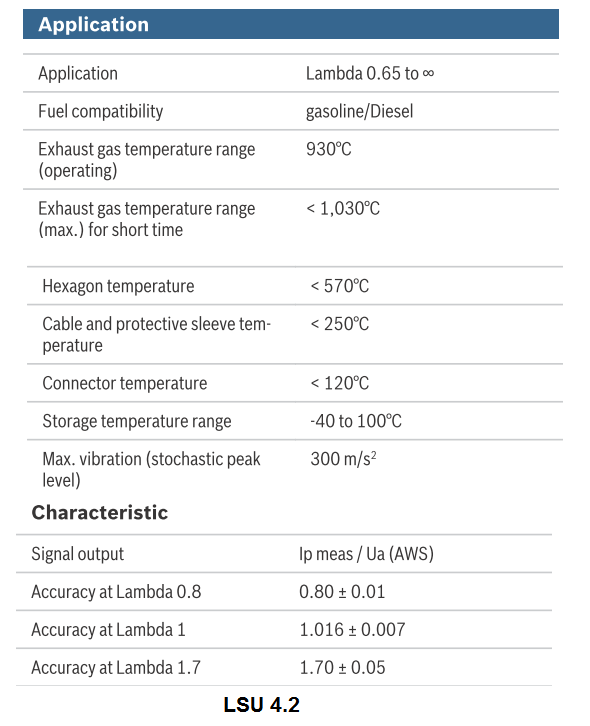
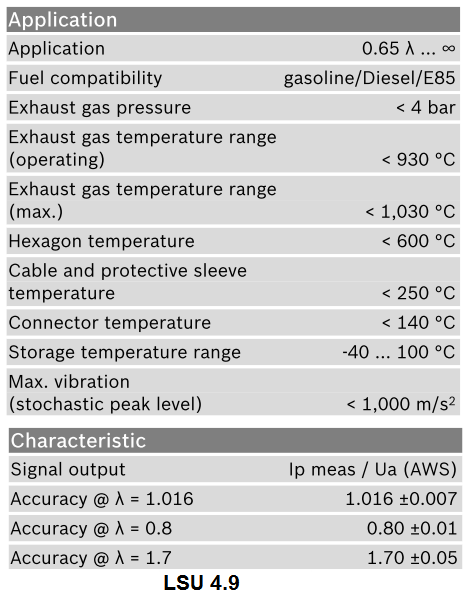
The only thing I see here that is different is the vibration spec. Most of the other specs are close enough that, unless there's something out there I haven't seen, they wouldn't test any differently when controlling for differences in the box that controls the sensor itself. Similar information exists for the Denso and NTK/NGK sensors if you know where to look... PM me if curious
To elaborate further: you could have multiple wideband "systems" (sensor + controller) that use the same sensor but have different capabilities in terms of electrical noise suppression, heater control logic, etc. Some systems can transmit data over a serial connection, although in this context everyone here is using an analog voltage output. Cobb systems for example (Evo, STi, GT-R, 335) can accept a serial input.
I have dug deeply into this issue of the actual sensors (just the sensors) and have acquired data on the following types:
-- Bosch LSM11, which is essentially a traditional narrowband with a slightly extended AFR range (mostly in the lean side)
-- Denso limiting-current type lean AFR sensor, mostly found on 80s lean-burn engines
-- Denso limiting-current type wideband AFR sensor, currently the stock wideband on many Japanese vehicles such as the Rx-8
-- NGK/NTK pump-cell type (same principle as Bosch LSU) sensor, found on 90s lean-burn engines
-- Bosch LSU 4.2, extensive data of which can be found on the internet
-- Bosch LSU 4.9, where I only have a spec sheet off the Bosch motorsports website.
Other sensors exist, like the Bosch LSU 4.7 and the Bosch LSU-ADV which is their latest sensor currently used on high-end German cars mostly. There are two things that are often addressed as these sensor designs are revised: the light off time for cold start emissions and the accuracy of the sensor at the stoichiometric point over time. There's a thing called a sensor signal shift (Air-fuel shift) where basically the sensor can lose accuracy and needs to be compensated for with a rear O2 sensor and catalyst oxygen storage model. Newer sensors have countermeasures to reduce this effect, so that emissions aren't affected too much.
I don't want to come into this thread overwhelming everybody with specs and diagrams, but if you download the spec sheets from Bosch's website you get the following information directly from the manufacturer:


The only thing I see here that is different is the vibration spec. Most of the other specs are close enough that, unless there's something out there I haven't seen, they wouldn't test any differently when controlling for differences in the box that controls the sensor itself. Similar information exists for the Denso and NTK/NGK sensors if you know where to look... PM me if curious
#22
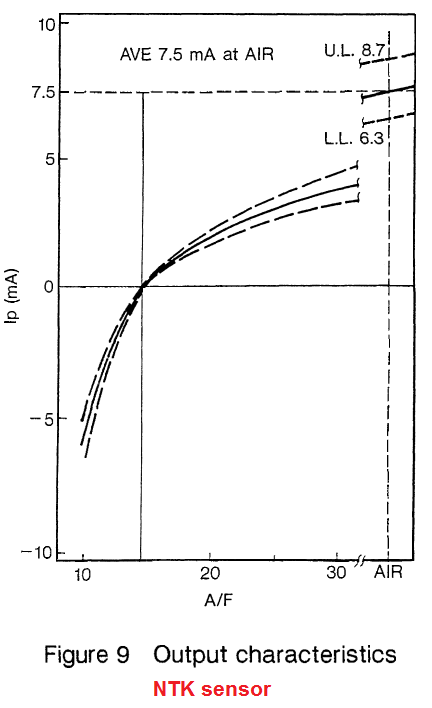
and here is a current chart for the Bosch LSU 4.2:
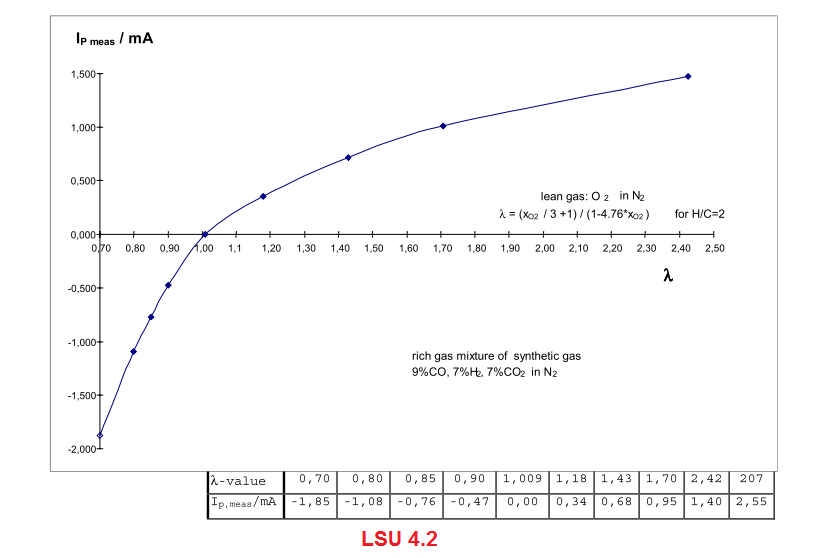
note that both graphs have current on the Y axis and AFR on the x axis, except the units vary (air/fuel ratio for NGK graph and lambda for Bosch graph).
The spec I have here for max allowable exhaust operating temperature on the NTK sensor is 950C, compared to the nominal 930C spec for the Bosch sensors. It will probably tolerate higher than that for short bursts, like the Bosch sensors.
I'm not too worried about that as I load the average of the cells in the INJ map to tell me what were looking at. I believe the 4.9 only reads down to 10 A/F (correct me if I'm wrong). I would much rather be lean in the decel/cruise than not reading in high boost. Am I the only one running really high boost on the streets?
The main point I want to make is that for most of our purposes, the controller probably matters more than the sensor. The sensors aren't all the same, but the pump-cell type sensors normally used in motorsports are pretty damn close. Their tolerance to lead poisoning might differ, or maybe some controllers are more sensitive to it. Overall though most of the differences between the sensors themselves are going to be related to emissions purposes rather than accuracy under heavily enriched, high temperature and high pressure conditions.
#23
Don't mean to thread jack but I just learned my car has ran for 2 years with out the o2 sensor hooked in, the wire was melted in half. Could I just put my wideband o2 inplace of the regular one or should I rewire the original and have a second bung installed?
Now on topic, my srt buddies have been running the 4.9 for a while with no problems once so ever and that's probly what ill go with.
Now on topic, my srt buddies have been running the 4.9 for a while with no problems once so ever and that's probly what ill go with.
#25
what people are not yet seeing in all this talk
is that SOME controllers also bring the abilty to data log rpm,, and expand and include map, coolant, fuel pressure inlet air temp and exhaust temp inputs
( and some,, even G forces for conering and accel/decel )
and can display real time on various gauges or on a simulated dash on a laptop
good units will have onboard logging memory built in ,, so you dont need to tow the lap top around with you
some daisy chain together expensively as little control modules
, others are all built in and have an expansion loom and you add the probes as you desire
some of these are not all that much more expensive than the basic lambda controller
,, and this expansion capability is well worth weighing up before you choose
im looking at moving on from a dynojet2
and frankly am put off by the innovate,, and disappointed at the aem options
i also need the custom narrow band out to tweak my LPG controller
so the best value i see ATM is with the 14point7 stuff , but im still looking
any reports how the latest SLC2 is measuring up?
is that SOME controllers also bring the abilty to data log rpm,, and expand and include map, coolant, fuel pressure inlet air temp and exhaust temp inputs
( and some,, even G forces for conering and accel/decel )
and can display real time on various gauges or on a simulated dash on a laptop
good units will have onboard logging memory built in ,, so you dont need to tow the lap top around with you
some daisy chain together expensively as little control modules
, others are all built in and have an expansion loom and you add the probes as you desire
some of these are not all that much more expensive than the basic lambda controller
,, and this expansion capability is well worth weighing up before you choose
im looking at moving on from a dynojet2
and frankly am put off by the innovate,, and disappointed at the aem options
i also need the custom narrow band out to tweak my LPG controller
so the best value i see ATM is with the 14point7 stuff , but im still looking
any reports how the latest SLC2 is measuring up?


